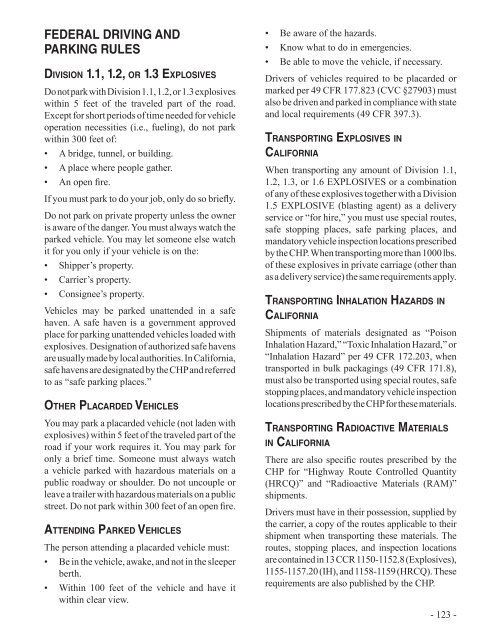Commercial Driver Handbook ( PDF ) - California Department of ...
Commercial Driver Handbook ( PDF ) - California Department of ...
Commercial Driver Handbook ( PDF ) - California Department of ...
You also want an ePaper? Increase the reach of your titles
YUMPU automatically turns print PDFs into web optimized ePapers that Google loves.
FeDeRAl DRIVIng AnD<br />
PARkIng RuleS<br />
division 1.1, 1.2, or 1.3 explosives<br />
Do not park with Division 1.1, 1.2, or 1.3 explosives<br />
within 5 feet <strong>of</strong> the traveled part <strong>of</strong> the road.<br />
Except for short periods <strong>of</strong> time needed for vehicle<br />
operation necessities (i.e., fueling), do not park<br />
within 300 feet <strong>of</strong>:<br />
• A bridge, tunnel, or building.<br />
• A place where people gather.<br />
• An open fire.<br />
If you must park to do your job, only do so briefly.<br />
Do not park on private property unless the owner<br />
is aware <strong>of</strong> the danger. You must always watch the<br />
parked vehicle. You may let someone else watch<br />
it for you only if your vehicle is on the:<br />
• Shipper’s property.<br />
• Carrier’s property.<br />
• Consignee’s property.<br />
Vehicles may be parked unattended in a safe<br />
haven. A safe haven is a government approved<br />
place for parking unattended vehicles loaded with<br />
explosives. Designation <strong>of</strong> authorized safe havens<br />
are usually made by local authorities. In <strong>California</strong>,<br />
safe havens are designated by the CHP and referred<br />
to as “safe parking places.”<br />
other plaCarded vehiCles<br />
You may park a placarded vehicle (not laden with<br />
explosives) within 5 feet <strong>of</strong> the traveled part <strong>of</strong> the<br />
road if your work requires it. You may park for<br />
only a brief time. Someone must always watch<br />
a vehicle parked with hazardous materials on a<br />
public roadway or shoulder. Do not uncouple or<br />
leave a trailer with hazardous materials on a public<br />
street. Do not park within 300 feet <strong>of</strong> an open fire.<br />
attending parked vehiCles<br />
The person attending a placarded vehicle must:<br />
• Be in the vehicle, awake, and not in the sleeper<br />
berth.<br />
• Within 100 feet <strong>of</strong> the vehicle and have it<br />
within clear view.<br />
• Be aware <strong>of</strong> the hazards.<br />
• Know what to do in emergencies.<br />
• Be able to move the vehicle, if necessary.<br />
<strong>Driver</strong>s <strong>of</strong> vehicles required to be placarded or<br />
marked per 49 CFR 177.823 (CVC §27903) must<br />
also be driven and parked in compliance with state<br />
and local requirements (49 CFR 397.3).<br />
transporting explosives in<br />
<strong>California</strong><br />
When transporting any amount <strong>of</strong> Division 1.1,<br />
1.2, 1.3, or 1.6 EXPLOSIVES or a combination<br />
<strong>of</strong> any <strong>of</strong> these explosives together with a Division<br />
1.5 EXPLOSIVE (blasting agent) as a delivery<br />
service or “for hire,” you must use special routes,<br />
safe stopping places, safe parking places, and<br />
mandatory vehicle inspection locations prescribed<br />
by the CHP. When transporting more than 1000 lbs.<br />
<strong>of</strong> these explosives in private carriage (other than<br />
as a delivery service) the same requirements apply.<br />
transporting inhalation hazards in<br />
<strong>California</strong><br />
Shipments <strong>of</strong> materials designated as “Poison<br />
Inhalation Hazard,” “Toxic Inhalation Hazard,” or<br />
“Inhalation Hazard” per 49 CFR 172.203, when<br />
transported in bulk packagings (49 CFR 171.8),<br />
must also be transported using special routes, safe<br />
stopping places, and mandatory vehicle inspection<br />
locations prescribed by the CHP for these materials.<br />
transporting radioaCtive materials<br />
in <strong>California</strong><br />
There are also specific routes prescribed by the<br />
CHP for “Highway Route Controlled Quantity<br />
(HRCQ)” and “Radioactive Materials (RAM)”<br />
shipments.<br />
<strong>Driver</strong>s must have in their possession, supplied by<br />
the carrier, a copy <strong>of</strong> the routes applicable to their<br />
shipment when transporting these materials. The<br />
routes, stopping places, and inspection locations<br />
are contained in 13 CCR 1150-1152.8 (Explosives),<br />
1155-1157.20 (IH), and 1158-1159 (HRCQ). These<br />
requirements are also published by the CHP.<br />
- 123 -

















